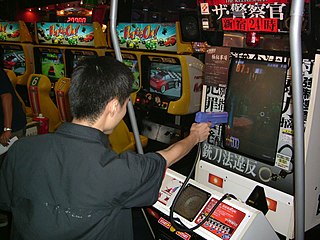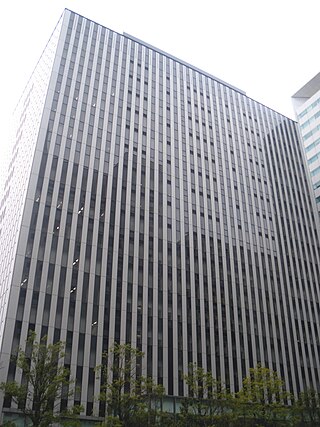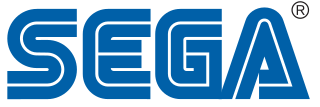Related Research Articles

An arcade video game takes player input from its controls, processes it through electrical or computerized components, and displays output to an electronic monitor or similar display. All arcade video games are coin-operated or accept other means of payment, housed in an arcade cabinet, and located in amusement arcades alongside other kinds of arcade games. Until the early 2000s, arcade video games were the largest and most technologically advanced segment of the video game industry.

Namco Limited was a Japanese multinational video game and entertainment company, headquartered in Ōta, Tokyo. It held several international branches, including Namco America in Santa Clara, California, Namco Europe in London, Namco Taiwan in Kaohsiung, and Shanghai Namco in mainland China.

Atlus Co., Ltd. is a Japanese video game developer, publisher, arcade manufacturer and distribution company based in Tokyo. A subsidiary of Sega, the company is known for video game series such as Megami Tensei, Persona, Etrian Odyssey, and Trauma Center, as well as Print Club (Purikura) arcade machines. Its corporate mascot is Jack Frost, a snowman-like character from their Shin Megami Tensei series. Outside of video games, the company is known for their Purikura arcade machines, which are selfie photo sticker booths popular in East Asia.
The Shining series is a brand of role-playing video games published by Sega, who owns the property. The first game, Shining in the Darkness, was a first-person dungeon crawler with randomly encountered, turn-based battles. The next game released in the series was Shining Force, which was a turn-based strategy style tactical role-playing game with battle scenes acted out with sprites. Other directions include Shining Soul, a dungeon crawl action role-playing game with roguelike elements, and a number of traditional Japanese role-playing games. Shining Resonance Refrain was released on PlayStation 4, Xbox One, Steam PC and Nintendo Switch worldwide across 2018.

Sega Sammy Holdings Inc. is a Japanese global holding company and conglomerate formed from the merger of Sega and Sammy Corporation in 2004. Both companies are involved in the amusement industry.

Sega AM Research & Development No. 2, previously known as SEGA-AM2 Co., Ltd., is a video game development team within the Japanese multinational video game developer Sega. Yu Suzuki, who had previously developed arcade games for Sega including Hang-On and Out Run, was the first manager of the department.

Banpresto Co., Ltd. was a Japanese video game developer and publisher headquartered in Shinagawa, Tokyo. It had a branch in Hong Kong named Banpresto H.K., which was headquartered in the New Territories. Banpresto was a partly-owned subsidiary of toymaker Bandai from 1989 to 2006, and a wholly-owned subsidiary of Bandai Namco Holdings from 2006 to 2008. In addition to video games, Banpresto produced toys, keyrings, apparel, and plastic models.

Sonic the Hedgehog is a video game series and media franchise created by the Japanese developers Yuji Naka, Naoto Ohshima, and Hirokazu Yasuhara for Sega. The franchise follows Sonic, an anthropomorphic blue hedgehog who battles the evil Doctor Eggman, a mad scientist. The main Sonic the Hedgehog games are platformers mostly developed by Sonic Team; other games, developed by various studios, include spin-offs in the racing, fighting, party and sports genres. The franchise also incorporates printed media, animations, feature films, and merchandise.

Sega AM Research & Development No. 1 is a development department within Japanese video game developer Sega that also previously existed as Wow Entertainment and Sega Wow Inc. AM1 spent most of its early existence under the leadership of Rikiya Nakagawa and developed a number of arcade games for Sega.
Nexon Co., Ltd. is a South Korean video game publisher. It publishes titles including MapleStory, Dungeon & Fighter, Sudden Attack, and KartRider. Headquartered in Japan, the company has offices in South Korea, the United States, Taiwan and Thailand.

iXIT Corporation, formerly known as Index Corporation, is a Japanese corporate information and communications technology company owned by Sawada Holdings.

Border Break, is a third-person mecha action arcade game developed and published by Sega. It is the first title to run on Sega's RingEdge arcade system board, and was released on September 9, 2009 in Japan, in Hong Kong on January 25, 2010, and in Taiwan on April 1, 2010. A PlayStation 4 version was released in Japan on August 2, 2018.

Sega Corporation is a Japanese multinational video game company headquartered in Shinagawa, Tokyo. Its international branches, Sega of America and Sega Europe, are headquartered in Irvine, California, and London. Its division for the development of arcade games and home video games, Sega Games, has existed in its current state since 2020; from 2015 to that point, the two had made up separate entities known as Sega Games and Sega Interactive Co., Ltd. Sega is a subsidiary of Sega Sammy Holdings. From 1983 until 2001, Sega also developed video game consoles.

The history of Sega, a Japanese multinational video game and entertainment company, has roots tracing back to American Standard Games in 1940 and Service Games of Japan in the 1950s. The formation of the company known today as Sega is traced back to the founding of Nihon Goraku Bussan, which became known as Sega Enterprises, Ltd. following the acquisition of Rosen Enterprises in 1965. Originally an importer of coin-operated arcade games to Japan and manufacturer of slot machines and jukeboxes, Sega began developing its own arcade games in 1966 with Periscope, which became a surprise success and led to more arcade machine development. In 1969, Gulf and Western Industries bought Sega, which continued its arcade game business through the 1970s.

Ryu Ga Gotoku Studio is a video game developer housed within the Japanese video game company Sega as part of its Sega CS Research and Development No. 1 division. It is known for developing the games in the Like a Dragon series, which the studio is named after, since Yakuza 5.

Shining Force Cross is an action role-playing game developed by Sega AM2 and published by Sega on the Sega RingEdge arcade platform. It is part of the Shining series from Sega. It is developed by the same development team as Quest of D. It was only released in Japan in arcades and received no port of any kind.
References
- 1 2 ついにネットワークに対応! 『スターホース2 セカンドフュージョン』 (in Japanese). dengekionline.com.
- ↑ "Appendix of Consolidated Financial Statements 9 Months Ended December 31, 2009" (PDF). Sega Sammy Holdings. February 5, 2010. p. 3. Retrieved 13 April 2012.
- ↑ "Appendix of Consolidated Financial Statements Year Ended March 31, 2010" (PDF). Sega Sammy Holdings. May 14, 2010. p. 3. Retrieved 13 April 2012.
- ↑ "Appendix of Consolidated Financial Statements Year Ended March 31, 2011" (PDF). Sega Sammy Holdings. May 13, 2011. p. 3. Retrieved 13 April 2012.
- 1 2 "Currency Conversion". XE.com . Retrieved 13 April 2012.
- ↑ "Appendix of Consolidated Financial Statements 9 Months Ended December 31, 2011" (PDF). Sega Sammy Holdings. February 3, 2012. p. 3. Retrieved 13 April 2012.